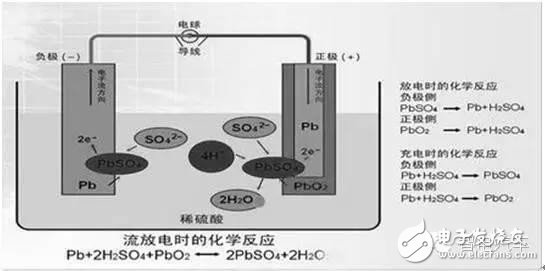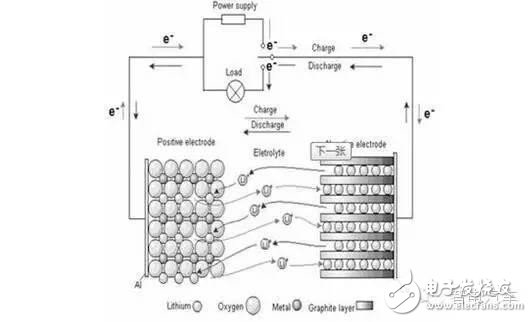At present, China's new energy pure electric vehicles have achieved a series of breakthroughs after more than ten years of research and development, and have begun to gradually enter the market, but there are still many problems. Among them, the endurance and power performance of electric vehicles are the focus of many problems. The power battery system is a key technical problem that limits the endurance and power performance. Here, this paper intends to introduce a certain introduction to the development status of the battery system of electric vehicles. At present, the power batteries used in pure electric vehicles mainly include lead-acid batteries, nickel-hydrogen batteries and lithium-ion batteries. The reaction principle diagram of the battery is as shown in the following diagrams (a), (b) and (c), and the basic properties are as follows. Figure (a) Working principle of lead-acid battery Figure (a) is a working principle diagram of a lead-acid battery. It mainly realizes the conversion between chemical energy and electric energy through chemical reaction, thereby realizing energy storage and discharge. At present, lead-acid batteries have mature technology, good over-discharge performance, good safety performance and low price. They are widely used in electric bicycles, electric motorcycles and low-speed pure electric vehicles, but they cannot meet the lower specific energy and specific power. The requirements for the driving range of pure electric vehicles have not been widely applied in pure electric vehicles. Figure (b) is a working principle diagram of a nickel-hydrogen battery. It is also mainly through the chemical reaction to achieve the conversion between chemical energy and electrical energy, thereby achieving energy storage and discharge. However, nickel-metal hydride batteries have advantages such as environmental friendliness, high current discharge, higher energy density than lead-acid batteries, and no memory effect. The disadvantage is that the voltage platform is low (1.2V), which is used in pure electric vehicles. A large number of series and parallel combination, resulting in poor battery consistency, battery management system is complex, restricting its use in pure electric vehicles. Figure (c) is a working principle diagram of a lithium ion battery. Figure (c) is a working principle diagram of a lithium ion battery. It mainly realizes the conversion between chemical energy and electric energy by ion migration, thereby realizing energy storage and discharge. The cell voltage of the lithium ion battery is three times that of the nickel hydrogen battery, and has the advantages of relatively large specific energy density, no memory effect, high charge and discharge efficiency, low self-discharge rate, long cycle life, and no pollution. Lithium-ion batteries have become the most widely used power battery in pure electric vehicles. Among them, the lithium ion battery represented by lithium iron phosphate ternary material can reach 130Wh/kg-140Wh/kg due to its energy density, and the charging and discharging platform is stable, the safety performance is good, the low temperature performance and the cycle life are better. On the 11th, at the Hefei China New Energy Vehicle Power Battery Materials Summit Forum, Huang Yunhui, dean of the School of Materials Science and Engineering at Huazhong University of Science and Technology, also said that lithium iron phosphate batteries are applied through nanotechnology and lithium-rich technologies. The energy density will be greatly improved, and the cost of the lithium iron phosphate battery of 2 yuan / watt hour or less is no problem. Therefore, the ternary material battery represented by lithium iron phosphate is now the main power source for pure electric vehicles. Although the development of energy density and other properties of lithium-ion batteries has been greatly improved, according to the current position of the fuel tank of the vehicle, and the weight of the battery meets the requirements of vehicle load capacity and axle load distribution, the specific energy of the power battery should reach 500-700Wh. /kg. The current energy density of lithium-ion batteries is much lower than this value. Therefore, improving the energy density of power batteries is a bottleneck problem that restricts the development of lithium-ion batteries. At present, in order to break through the bottleneck of the battery with low energy density, domestic and foreign scholars have mainly done the following research. In terms of materials, silicon-based and tin-based alloys are used as negative electrode materials for lithium ion batteries. The theoretical capacity of the improved lithium ion battery through this material can be as high as 4200Wh/kg and 990Wh/kg, respectively, which can fully meet the energy requirements of pure power vehicle power battery, but the silicon-based lithium ion battery generates huge materials due to charge and discharge process. The volume expansion effect, and the relatively small diffusion coefficient of lithium in the silicon film, the electrochemical performance is significantly deteriorated; the tin-based alloy negative electrode material battery needs to solve the problem of high irreversible capacity for the first time and poor charge and discharge cycle performance, which is currently not available in pure electric The automotive power battery field has been industrialized. On the other hand, it is mainly to make breakthroughs in preparation technology and group technology. Considering the comprehensive preparation technology of the battery, nanotechnology is used to improve the performance of the battery and develop a new type of nano material. From the perspective of group technology, the modular structure of the power battery system can be rationally designed to reduce the performance degradation caused by the battery pack composed of battery cells, and reduce the influence of the consistency of the battery cells in the battery pack; The battery system performs energy management to achieve further rational allocation and utilization of energy. At present, it mainly focuses on the energy management, charge and discharge balance, and SOC estimation of the battery pack. In the research of battery pack energy management, domestic and foreign scholars have done a lot of research on the energy management allocation strategy of hybrid electric vehicles, and summarized the power following control strategy, the control strategy and the fixed factor power allocation. A series of energy management control strategies such as control strategy and fuzzy control strategy. Based on the above analysis, the current pure electric vehicle power battery, mainly using lithium-ion batteries. The main technical bottleneck for improving performance is to further improve the performance level of pure electric vehicle single battery and improve the management of pure electric vehicle power battery system.
If you are new to the concept of using an electric
kettle, you might be overwhelmed by the variety of electric
kettles that are displayed on the store shelves and have difficulty deciding which one would be
the best to suit your individual needs or desires. This
introduction will give you some basic
information about some of the features that are available on
various types of electric kettles so that you can make a more informed decision
when choosing one for use in your home.
Features:
Spend few minutes to boil : After 5 minutes, hot water will
finish for you to drink.
3 protection functions : The on/off button is on the handle, making
it easy to turn the kettle off when you pick it up. A concealed heating unit reduces
the amount of buildup in the kettle.
It will be a problem when you forget to
close the button.Once the water boils the kettle shuts itself off.Do not have
to worry about damaging it by letting it run dry. When water runs dry,It will
cut the electric by itself.
Multiple Cups: Water can be loaded to
1.8Liter.
Materials :
Food grade stainless steel, more healthy
and hygienic. PP handle wieh heat insulation material provides scald
resistance. Durable controller performance with 360 degree rotation cordless
base design.
OEM & ODM service : Try
best to support you during production and provide better after-sales
service.Enhance your brand popularity.
Application:
Make a cup of tea.
Boil eggs.
Cook noodles.
Electric Water Kettle Electric Water Kettle,Aluminium Electric Water Kettle,Mini Electric Water Kettle,Stainless Steel Electric Water Kettle Guangzhou Taipeng Electrical Appliances Technology CO., LTD. , https://www.kettles.pl

Figure (b) Working principle diagram of nickel-metal hydride battery 